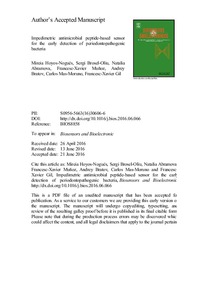Mostra el registre d'ítem simple
Impedimetric antimicrobial peptide-based sensor for the early detection of periodontopathogenic bacteria
| dc.contributor.author | Hoyos Nogués, Mireia |
| dc.contributor.author | Brosel, Sergi |
| dc.contributor.author | Abramova, Natalia |
| dc.contributor.author | Muñoz, FJ |
| dc.contributor.author | Andrey, Bratov |
| dc.contributor.author | Gil Mur, Francisco Javier |
| dc.contributor.author | Mas Moruno, Carlos |
| dc.contributor.other | Universitat Politècnica de Catalunya. Departament de Ciència dels Materials i Enginyeria Metal·lúrgica |
| dc.date.accessioned | 2017-02-23T10:37:39Z |
| dc.date.available | 2018-12-15T01:30:41Z |
| dc.date.issued | 2016 |
| dc.identifier.citation | Hoyos, M., Brosel, S., Abramova , N., Muñoz, F., Andrey, B., Gil, J., Mas-Moruno, C. Impedimetric antimicrobial peptide-based sensor for the early detection of periodontopathogenic bacteria. "Biosensors and bioelectronics", 2016, vol. 86, p. 377-385. |
| dc.identifier.issn | 0956-5663 |
| dc.identifier.uri | http://hdl.handle.net/2117/101442 |
| dc.description.abstract | Peri-implantitis, an inflammation caused by biofilm formation, constitutes a major cause of implant failure in dentistry. Thus, the detection of bacteria at the early steps of biofilm growth represents a powerful strategy to prevent implant-related infections. In this regard, antimicrobial peptides (AMPs) can be used as effective biological recognition elements to selectively detect the presence of bacteria. Thus, the aim of the present study was to combine the use of miniaturized and integrated impedimetric transducers and AMPs to obtain biosensors with high sensitivity to monitor bacterial colonization. Streptococcus sanguinis, which is one of the most prevalent strains in the onset of periodontal diseases, was used as a model of oral bacteria. To this end, a potent AMP derived from human lactoferrin was synthesized and covalently immobilized on interdigitated electrode arrays (IDEA). X-ray photoelectron spectroscopy (XPS) and electrochemical impedance spectroscopy (EIS) were employed to optimize and characterize the method of immobilization. Noteworthy, the interaction of Streptococcus sanguinis with AMP-coated sensors provoked significant changes in the impedance spectra, which were univocally associated with the presence of bacteria, proving the feasibility of our method. In this regard, the developed biosensor permits to detect the presence of bacteria at concentrations starting from 101 colony forming units (CFU) mL-1 in KCl and from 102 CFU mL-1 in artificial saliva. Moreover, the system was devoid of cytotoxicity for human fibroblasts. These results indicate that the proposed approach can be effective in the detection of initial stages of biofilm formation, and may be useful in the early prevention and treatment of peri-implantitis |
| dc.format.extent | 9 p. |
| dc.language.iso | eng |
| dc.rights.uri | http://creativecommons.org/licenses/by-nc-nd/3.0/es/ |
| dc.subject | Àrees temàtiques de la UPC::Enginyeria dels materials |
| dc.subject.lcsh | Antimicrobial Cationic Peptides |
| dc.subject.lcsh | Dental Implantation |
| dc.subject.lcsh | Dental Prosthesis Design |
| dc.subject.lcsh | Biosensing Techniques |
| dc.subject.other | Impedimetric biosensors |
| dc.subject.other | Antimicrobial peptides |
| dc.subject.other | Peri-implantitis |
| dc.subject.other | Bacterial detection |
| dc.subject.other | Biofunctionalization |
| dc.title | Impedimetric antimicrobial peptide-based sensor for the early detection of periodontopathogenic bacteria |
| dc.type | Article |
| dc.subject.lemac | Pròtesis dentals |
| dc.subject.lemac | Biosensors |
| dc.contributor.group | Universitat Politècnica de Catalunya. BBT - Biomaterials, Biomecànica i Enginyeria de Teixits |
| dc.identifier.doi | 10.1016/j.bios.2016.06.066 |
| dc.description.peerreviewed | Peer Reviewed |
| dc.relation.publisherversion | http://www.sciencedirect.com/science/article/pii/S0956566316306066 |
| dc.rights.access | Open Access |
| local.identifier.drac | 19721893 |
| dc.description.version | Postprint (author's final draft) |
| dc.relation.projectid | info:eu-repo/grantAgreement/EC/FP7/321985/EU/Development of new biofunctionalized materials for application in regenerative medicine/BIOMAT4BIOMED |
| dc.contributor.covenantee | Center for Research in NanoEngineering (CRNE) |
| local.citation.author | Hoyos, M.; Brosel, S.; Abramova, N.; Muñoz, F.; Andrey, B.; Gil, J.; Mas-Moruno, C. |
| local.citation.publicationName | Biosensors and bioelectronics |
| local.citation.volume | 86 |
| local.citation.startingPage | 377 |
| local.citation.endingPage | 385 |
Fitxers d'aquest items
Aquest ítem apareix a les col·leccions següents
-
Articles de revista [960]
-
Articles de revista [438]


